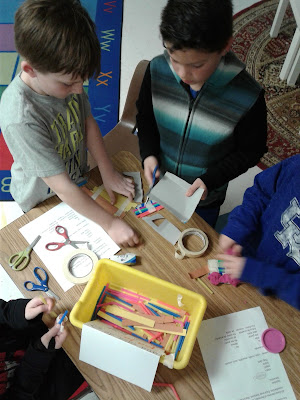I don't know what other people do at conferences but I pick sessions in several different ways. One way I pick sessions is based on who is presenting. If they've got a reputation for being a great presenter then I go. So when my co-worker Ben suggested I go to Greta Lundgaard's session because she was great, I went. And guess what? She was great.
Her presentation was on the gradual release model of teaching and how to use it in World Languages. There are four stages - I DO, WE DO, YOU DO TOGETHER, YOU DO ALONE. Turns out I'm pretty good at stages 1, 2, and 4 but almost never do stage 3 - YOU DO TOGETHER.
While I sat there a light bulb went off in my head. I had just finished having my 4th and 5th graders write a description of themselves to go with self-portraits they had made in art class. They had watched me write a description of myself. We had written one together. And then I sent them off to write their own.
For some kids it was no problem but for most it was like pulling teeth. And I realized it was because we had missed that important step of YOU DO TOGETHER. I also think they could've done with some more initial input but this is my first year with this curriculum and I'm still working out the kinks. YOU DO TOGETHER is also a good time to walk around and check on students or work with groups that need more help. Next year I need to pull my struggling students and work with them in a small group while I let everyone else work together.
Greta also talked about slowly taking away the scaffolding. If they couldn't do it then you put it back and then later take it away again. She used the example of having students write about what they did over the weekend. Even just saying don't forget to use preterite and imperfect is a form of scaffolding. Again, I realized I had been doing that. I say things like "Don't forget to use a complete sentence." And then I point to our sentence frames on the wall ALL THE TIME. It's ok to do this but by the end of the unit/year/5th grade they really need to be able to do that without my reminder if they're truly performing at the Novice High level.
So what does that mean for this unit next year?
1. More initial input so students can see and hear the structures Soy ____ and Es ______. I have a few authentic resources and some readers I want to add next year to help with this. Our list of words was also way too long. I need to narrow it down so students don't get overwhelmed.
2. When it comes to writing we are going to do YOU DO TOGETHER where students will write a paragraph describing each other, a famous person, etc. I think we need to do this several rotations so that they can improve on their work each time. Giving them one to correct would also help them recognize the patterns and identify those same mistakes in their own writing. Bonus - this definitely connects to core content and I will ask classroom teachers if there is anything specifically in the writing process I need to emphasize.
3. Differentiate - while students are working in pairs I will make sure to pull a small group of students who need extra help and work with them where they need it.
4. Pull the scaffolding away. It's ok for me to remind students to write in complete sentences but eventually they need to know to do it on their own.
Hoping next year this unit will go smoother! How do you get your students to write at a higher level? How and when do you pull away scaffolding? Share in the comments below!
Hoping next year this unit will go smoother! How do you get your students to write at a higher level? How and when do you pull away scaffolding? Share in the comments below!





